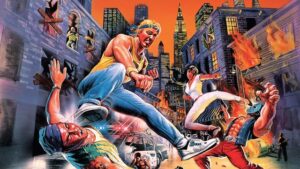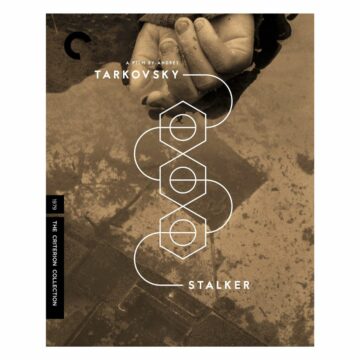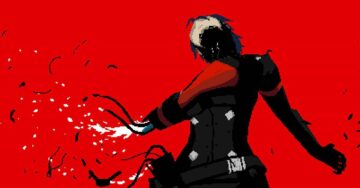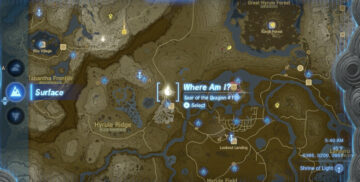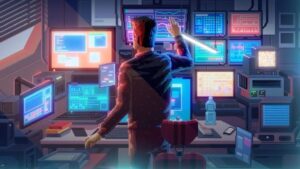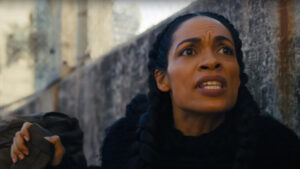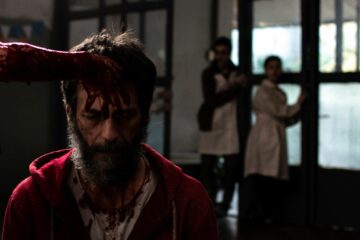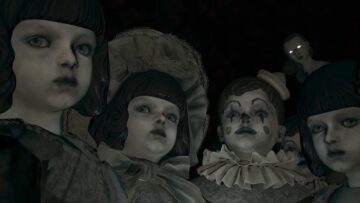Rebel, wunderkind, trendsetter, pioneer, one-man band — all labels applied to Steven Soderbergh more regularly than, say, “winner of the Academy Award for Best Director” or “youngest-ever Palme d’Or recipient.” Whatever the filmmaker’s independent-leaning bona fides (and the list goes deeper than any one person can keep in their head simultaneously), Soderbergh’s current run is a fertile, three-medium collaboration with Men in Black and Bill & Ted screenwriter Ed Solomon. In 2017, the two ever-so-slightly broke apart the possibilities of narrative and distribution with Mosaic, an interactive, app-based, deliriously entertaining murder mystery (no longer online but since re-edited by Soderbergh into a strong HBO series); 2021 brought No Sudden Move, an Elmore Leonard-esque thriller far more surprising and experiment-friendly than its streaming debut might suggest; and now they’re back with the complex, formally audacious miniseries Full Circle on Max.
In Full Circle, a child is kidnapped off the streets of New York — just not the one the kidnappers were trying to kidnap. But for the wealthy targets, the incident spills decades’ worth of skeletons from the closet — and a conspiracy across two continents, two families, and multiple generations reaping what’s been sown. The show feels equal parts Soderbergh and Solomon, the latter again imprinting his interest in secrets as crime’s great motivator — especially as those secrets uphold the public face of generational wealth — while the former’s directing-editing-cinematographer duties make it immediately identifiable after, say, one second. It blends readily identifiable actors (Timothy Olyphant, Claire Danes, Dennis Quaid, CCH Pounder) with a cast of up-and-comers; its location work puts most other New York productions to shame; and as a sprawling narrative it is more or less impossible to guess the who-what-when-where-why of its unfolding.
Lest it seem Soderbergh’s resting easy, July also saw the surprise premiere of Command Z, a project that blurs the line between film and series and — despite also shooting in New York — breaks from most anything Full Circle resembles or even suggests. No surprise for his fans: This is the director who immediately followed the 12-month run of Traffic, Erin Brockovich, and Ocean’s Eleven with Full Frontal (I’ll give you a second to look it up) and Solaris (maybe his best film; it got an F CinemaScore). Or who helped innovate the day-and-date theater/VOD split with Bubble. Or readily embraced shooting movies on iPhones. Or followed his two-part Che Guevara biopic with a lo-fi experiment starring an adult-film actress. Or who… oh, I could keep going, but once I’m finished listing examples it’ll be time to write about another film, series, app, whatever Soderbergh’s just debuted.
Safe to say it’s fruitful ground for speaking with the director, who I joined on a Zoom roundtable with two other journalists. The below represents my questions, but even sufficient time with Soderbergh is hardly scratching the surface of where we might go.
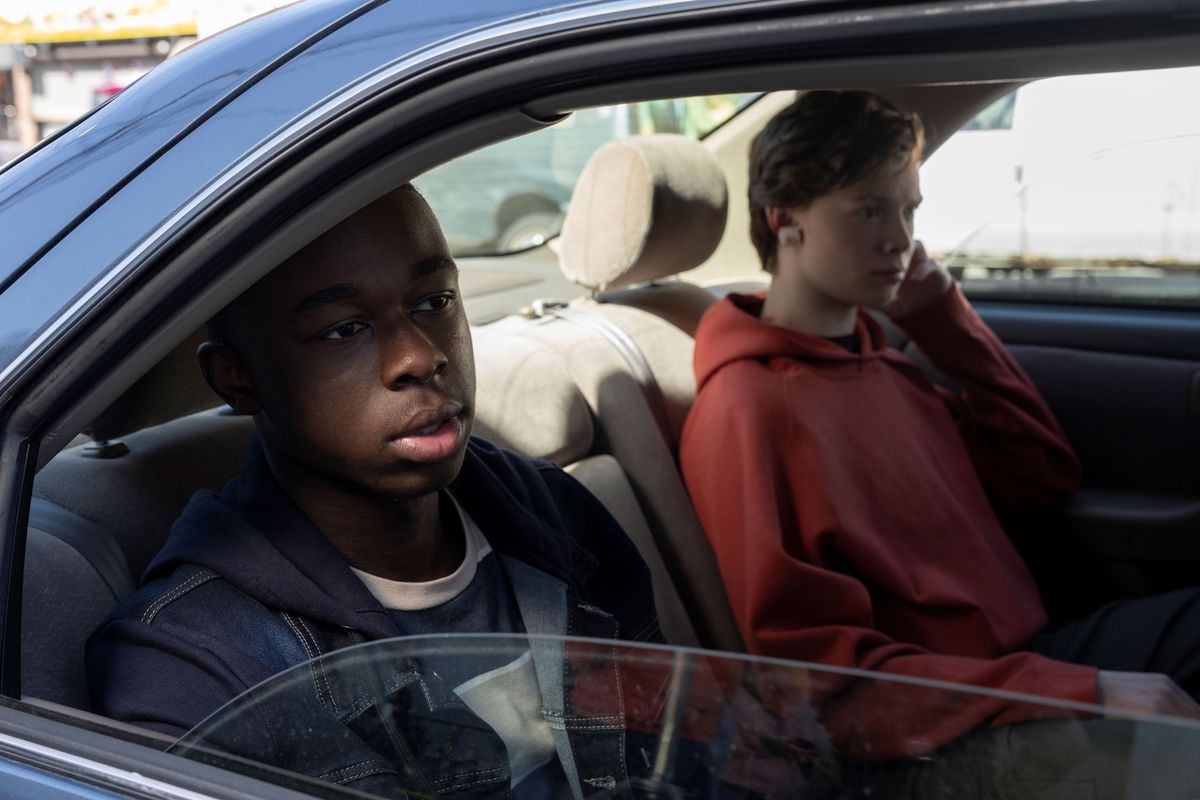
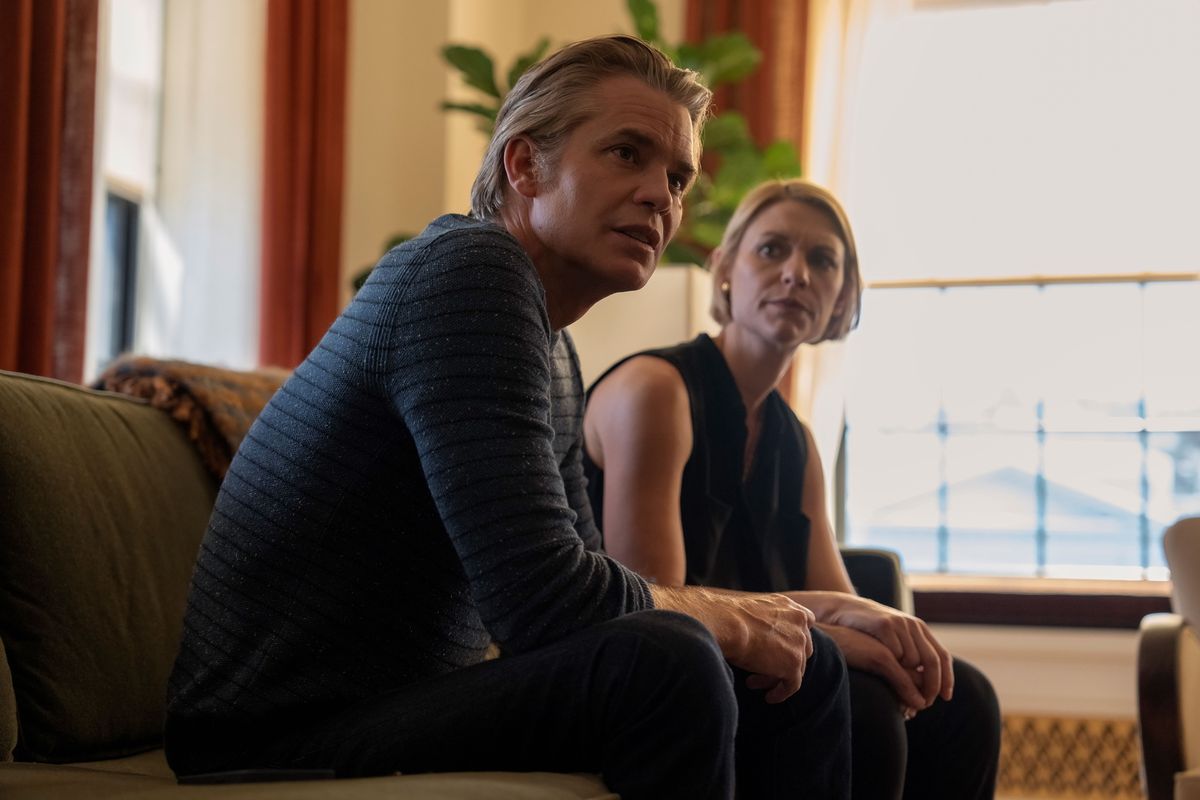
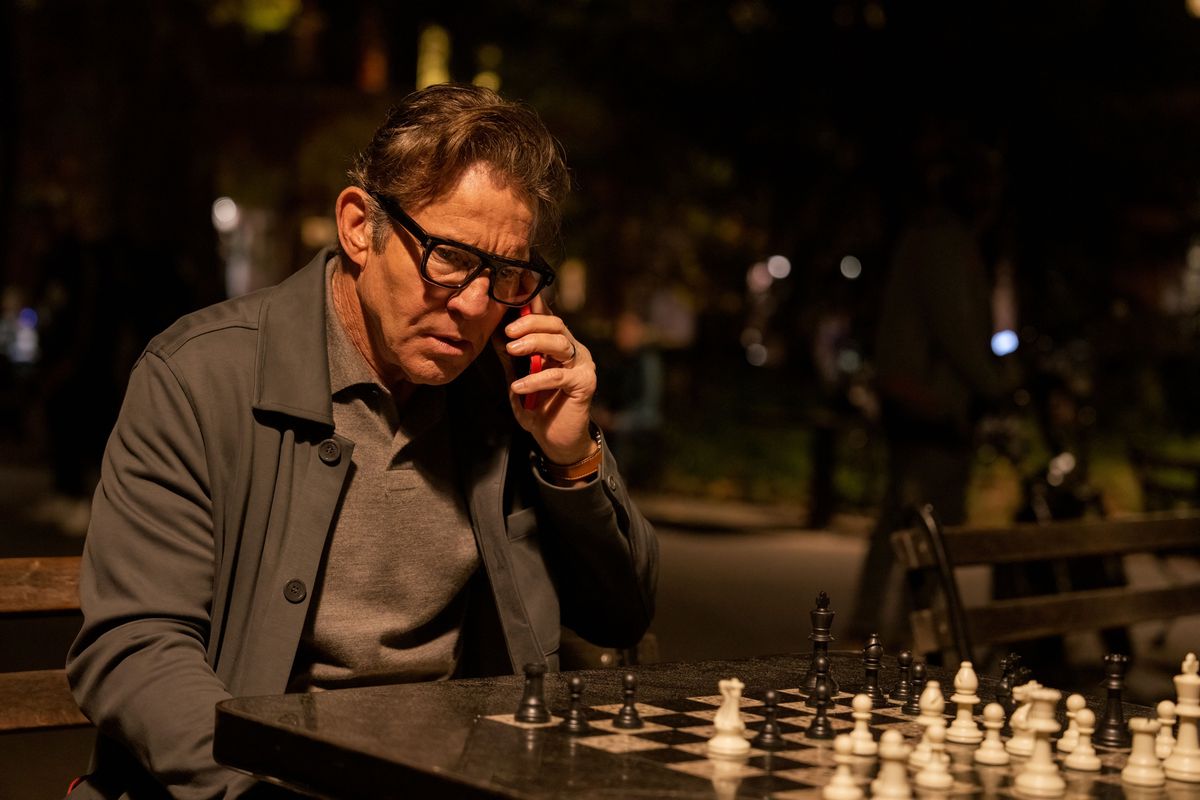
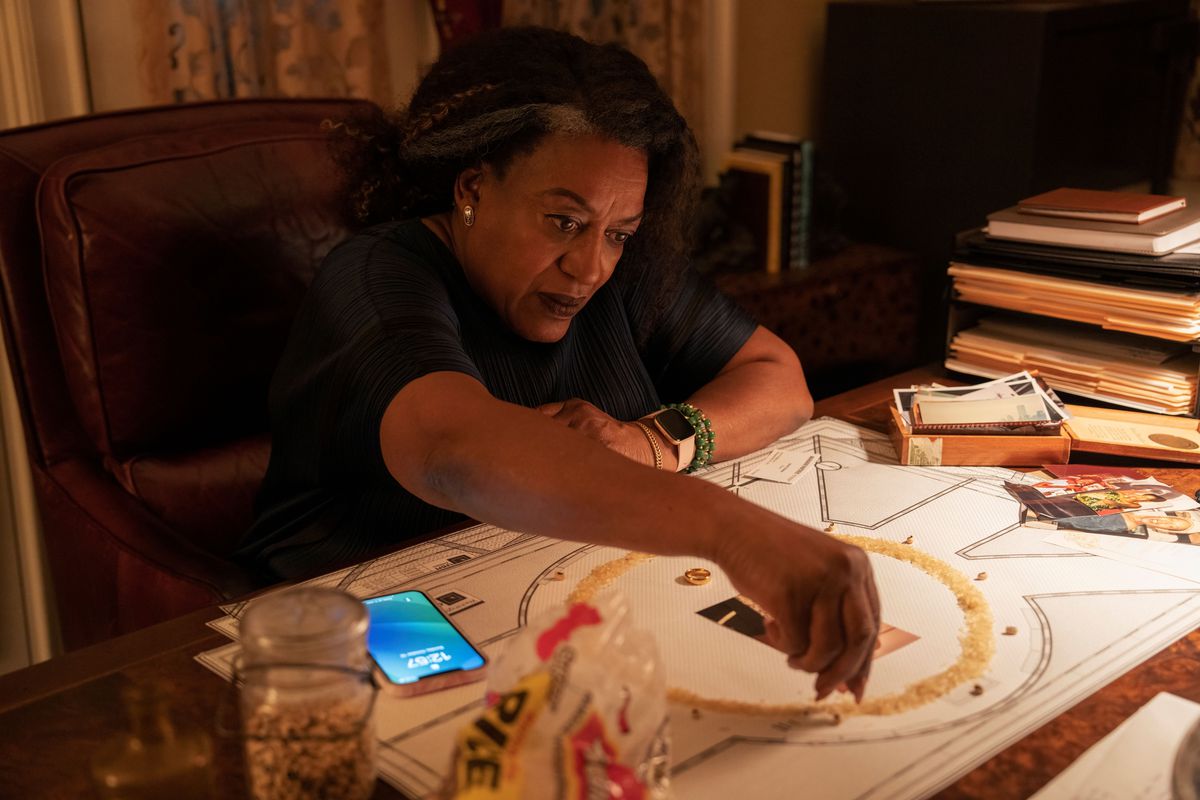
Full Circle
Polygon: Full Circle brings you back to television for the first time in earnest since The Knick. If there’s a connection it’s in both shows’ handheld, roving style. How much of that is about the demand of the format and how quickly you need to get it done? Do you think of film and TV as two different styles?
Steven Soderbergh: The Knick is almost exclusively handheld. There’s probably half a dozen shots that are in “studio mode,” probably because I was using a zoom. Whereas in Full Circle there are more shots in “studio mode.” That would depend on what the scene was and how long I felt I was going to be holding a shot, and then how the shot was going to develop in terms of the staging.
One example: Early in episode 3, where we see the Brown family for the first time, I start close on this bag of drugs that they’ve gotten to calm Derek [Olyphant] down. I come out with him into the living room; the four of them are talking; then Sam [Danes] goes back into the kitchen, picks up the drugs, and walks back over to Derek. I wanted to keep all that sort of moving in one shot, but I also wanted the camera to be adjusting itself vertically as we were going. That very quickly became a shot: When you’re starting 18 inches from that bag, pulling all the way into the other room, up into the corner, handheld — that would’ve just become distracting and not as elegant. So it really depended on what I wanted people to be paying attention to and what kind of energy the scene required.
As far as speed: That’s not so much of a factor to me because we can set up shots — like the one I just described — and execute them pretty quickly. The thing that takes time when you have a lot of work in a day is unnecessary coverage. And so if you can rehearse and block and stage something and know where the cuts are coming before you shoot it — and you don’t capture any redundant material, you’re not doing 20, 30 takes — you can move pretty quickly. I do like to move quickly, not just because it keeps the actors hot, but also I don’t like to burn my crews out. Let’s say we average a 9.5, 10-hour day. Part of that is because, again, people need to stay fresh. The other is making sure that I have enough time after the shoot is over to get all the material, cut that day’s footage together, and know whether there’s something we need to go back and do again as quickly as possible. So that means, sometimes, calling the 1st AD at 9 or 10 at night saying, “You need to put on the call sheet tomorrow that I want to redo these two shots we did today.”
That happens a couple of times a week at least. It’s also an awareness that if I say, “We’re shooting a 10-hour day, so call time is 8 and shooting wrapped at 6,” I’m very aware — because of how wound into the crew I am because of the jobs I’m performing — that there were people there many hours before shooting call and there will be many there many hours after shooting call. Their day is not a “10-hour day”; their day is more like a 14- or 15-hour day, even on a “short” day. So — in the aid of not grinding people to dust — I try to be very cognizant of how long things are taking and how long the days are.
Do you have an estimate of how long the shooting schedule was on Full Circle, and how that compares to a two-hour feature?
The total, I think, ended up being — with all the reshoots — around 72, 73 days. That’s the same amount we shot both seasons of The Knick; that was 10 hours. My average, typically, for a two-hour movie has been about 35 days. So it was kind of in the middle, somewhere. But unlike The Knick, during the editing process I think we threw out 65, 70 minutes of edited material and reshot an equal amount, so it was a pretty sizable overhaul.
As a New Yorker I was taken with Full Circle’s location work — including areas most directors just wouldn’t go to. I looked up storefronts and couldn’t believe how far out you traveled in some cases. Even more obvious locations like Washington Square Park are used to their full advantage — if you really know that space, each entrance, exit, and bench is utilized for maximum impact. When you took a directing sabbatical there was a quote I always remembered about how much you hate getting in the van to scout. But Full Circle feels like the work of somebody who got in the van and found the perfect spots to stage the action.
Yeah, I still hate it. But there’s no way around it. I’ve experimented with some of the technology that’s available when you send a scout out. They can wear this thing that’s essentially like one of the Google Street vans and walk through a space and upload it for me, and it’s a 360-degree capture that I can pan, tilt, do everything and see it, and that’s helpful. It’s a good tool, but I know from experience I have to go. Like, you have to go — it’s just different. Being there is just different. What often happens — no matter how exhausted your location scout is — is: You’ll roll up to a location and be looking around and then end up seeing something, or finding something near there that you hadn’t seen before that you like better. That’s why you’ve always got to get in the van: You need to see not only what they photographed for you or were showing you, but what’s around you that they didn’t show you or may be better or spark a different approach to the piece.
[embedded content]
I’m a little frustrated at my inability to integrate an idea that I was working on earlier, of having more shots of the various neighborhoods that were sort of contextual establishing shots — shots that backed off more, where you saw the entire neighborhood as opposed to the house on the street where we were. I went out a couple times looking for angles and wasn’t happy with what I was finding. I also am kind of allergic to establishing shots in general; I use very few of them and only when I think not using one would become either disorienting or claustrophobic. Even on a movie like Contagion, which is all over the world, there are no aerial shots. If there’s a shot there is either a character in it or it is the most blunt establishing shot possible to let you know exactly where you are. But I feel like those are — especially in the last 10 years or so with the advent of fantastic drone technology — sort of abused.
But I had in mind, before we started shooting, this whole idea — these sort of tableaus for each part of the city. I didn’t execute it properly. I probably should’ve just hired a pure second unit director or cinematographer to go out over the course of the shoot and just shoot a bunch of stuff. If I didn’t like it I wouldn’t use it, and if I got one or two shots, fine — but I didn’t do that. That may be an idea that I holster for another project, whether it’s a New York project or something that shoots in a different city. It was just one of those ideas that never developed properly.
Having ideas that don’t develop properly — how much does that color your relationship with a work after it’s done? You’ve said in the past you don’t have many regrets because, ultimately, each choice brought you where you are now.
There are cases where you do everything that can be done, given the time and the resources that you’ve got. Like I said, you work it out. Nothing makes me crazier than seeing a movie or a TV show where they clearly spent a lot of time “polishing the vase,” so to speak, and not a lot of time solving gigantic plot holes or dealing with somebody in a lead who’s horribly miscast. That’s always astonishing to me. And instructive. My initial view is what we call the “side-of-the-barn problem.” Like, is there something massive here that we’ve got to deal with? And let’s prioritize, in terms of the scale of the problems that we’re trying to fix.
So the results sometimes can be — when the thing is done and you’re looking at it over and over again — a collection of little things that annoy you because you just couldn’t get to them. You didn’t have the time or the money to fix every little thing; that’s just part of the process. I fix everything that I can think of that we can get the resources to fix, and then when it’s done it’s over. In the case of — like I said — that idea that never really took hold, that just goes in the bucket. That’ll pop up somewhere else, some other project; I don’t worry about those so much. But, you know, it’s rare that you make something and think, Oh, I wouldn’t touch that. It’s very rare.
[embedded content]
I watched Command Z, the miniseries you just released on your own website. I was surprised to discover your editing alias “Mary Ann Bernard” took a break and you worked with editor Francesca Kustra. Was that an experiment unto itself?
I was initially not going to direct Command Z. Then it turned out — through a variety of circumstances, or just the way things played out — I was going to have to do it. That wasn’t the plan, for me to direct all of Command Z. So what we had to do was shoot that while I was prepping Full Circle and trying to finish Magic Mike[‘s Last Dance], and it became obvious: I can’t do all these things at the same time. I need a break here. Hiring a proper editor was the only way to go.
I met Francesca because she was one of the editors on the Eugene Jarecki film The King that I was an executive producer on a couple years ago. So I spent a couple days with Eugene and his editorial team going through that movie. She and I were having conversations during that time; I thought she was talented, smart, hardworking. So when I realized there was no universe I could edit Command Z while I’m editing and shooting Full Circle, I called her up. She’s a documentary film editor, and I called her up and said, “I know you haven’t done anything exactly like this before, but if you’re up for it I would really like you to do this.” She said sure and she ended up doing a great job — so it was really desperation-slash-practical necessity that made me look outside the tent a little bit.
But I’m really glad I did. It was the right thing to do; it was nice to have another set of eyes on that particular project. We were moving so quickly, and I was trying to focus on getting Full Circle up and running. I really had forgotten, like, how many VFX shots were in Command Z. The tracking of that — the building of spreadsheets to track every visual effects shot in a show and show the status, how many versions had come in — is real laborious. It turns out it’s something Francesca is very good at. Because there’s, like, 270 effects shots in that thing, which is more — by a factor of, you know, five — than I’ve had in almost any movie I’ve ever made. I just totally forgot that every time we see Michael Cera, that’s a visual effect. I’m just imagining him as the fourth person in the room and not thinking that far ahead. Having to be a sort of one-person band for all of that was really critical.
There was an initial version that you shot and threw out, which was TikTok-centered and involved, as you have said, people from the future talking about our current world. Does that format especially interest you from both a formal angle — camera setup, editorial tricks — but also its means of distribution and exposure, which you’ve experimented with so much in your career?
It’s not really suited to the kind of narrative that I’m built for, is what I discovered. It clearly has become a very important format. But for things to work in that format they really have to fall within a certain style of storytelling, and it’s not one that really rewards something that takes a little time to set up. I mean, the amount of time you have to hook somebody with a TikTok video — we’re talking seconds. Especially if you want the algorithm to keep pushing it out to more people. It just became obvious once we looked at all of these videos: These are not going to get shared. Their storytelling rhythms are too slow.
Like I said, that was a big version of trial and error because we spent a lot of time making these. I think there were 18 of them. But it was obvious to me: These don’t work. Like, as TikTok videos, these TikTok videos don’t work. We should return to a format that I feel more comfortable in and that I feel I have a facility for, so I just… I felt old. But also, like I said, the ideas we were trying to present just didn’t lend themselves to the things that TikTok does well.
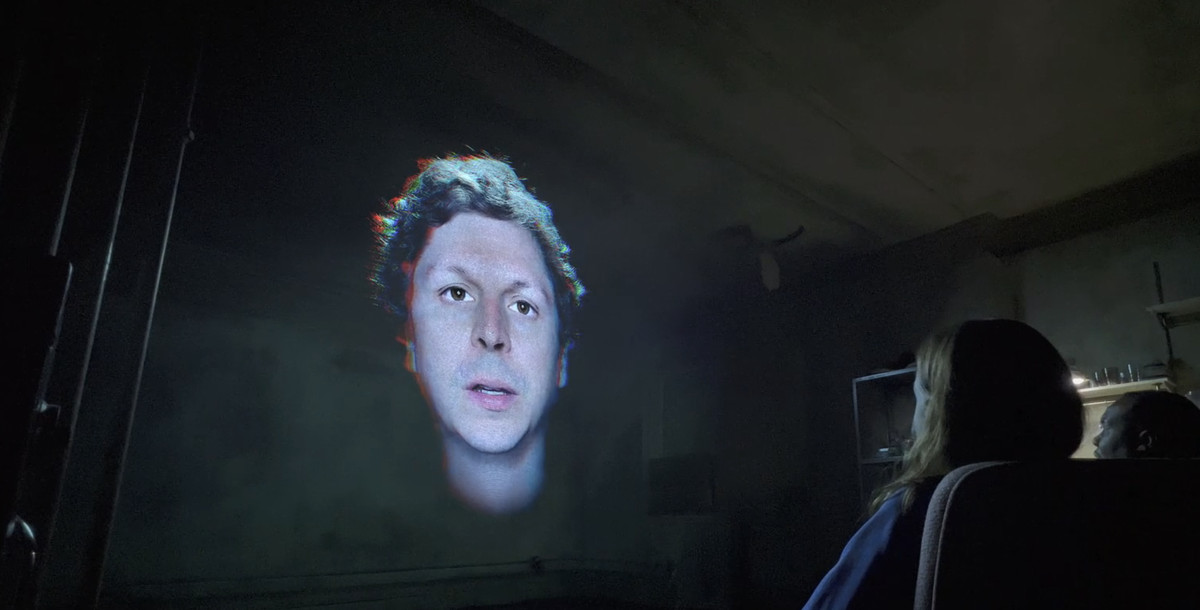
Still, you do have to hold an audience’s attention by working in such a close-quarters space. And you don’t really overwork yourself by doing an extravagant number of setups. I know you’re a big Roman Polanski admirer, and from Knife in the Water all the way up to An Officer and a Spy just a few years ago, nobody covers an interior better than him. Not that he’s per se an influence here. But where do you begin approaching these tight spaces?
Well, a couple people in a room is something I’ve always been drawn to. That’s all the first film I made is, really: a series of scenes with two people in a room. That doesn’t scare me; I’m not afraid that it will be boring. I feel, philosophically, that’s how everything significant that’s happened in the world began, was with two people in a room. I’m always excited by the possibilities of that, and so my focus is less on “How do we shoot that?” because I think that becomes pretty apparent, but “Do we have something worth shooting?” That’s the question that you ask when you show up on set. That’s why there are times when, if I don’t feel like we have something worth shooting, I send everybody away and it’s just the cast and the writer and I going, OK, we have to figure out why this doesn’t feel alive. What’s wrong? And you just start going through that process.
The [Full Circle] scene in which Louis [actor Gerald Jones] comes into the apartment to try and steal the painting was rethought on set at a certain point. I shot everything in it that made sense to me, and then I stopped and said to Ed, “Now I want to rethink what comes next.” Because in the original script it turned into, like, a fight in the bedroom: The gun was under the bed and the mattress flipped over and pushed her against the window and it looked like the window was going to crack. There was no exchange between the two of them. This was an example of when you’ve been shooting for a while. What I said to Ed was, “That doesn’t feel like what we’re making now, the scene that used to be on paper.” At a certain point you just go, I think we’re making a different show now and we need to look at this differently.
And we sat there on set, with the cast, and rebuilt the second half of that scene, which began when he moves from her to try pulling the painting off the wall. That was the point at which I say, “From here on out everything has to be different.” And we spent an hour, hour and a half talking through, writing, rehearsing what you see in the show now: He can’t get the painting off the wall, he runs back to find her, she’s got the gun, she confronts him, and he explains how he got there and why he’s there. And you see her realize, This is all my fucking fault. This whole thing. This kid is in this apartment because of the shit I did 20 years ago. And the show needed that moment. It didn’t exist. So that was an example of, yeah, I like to move quick until we bump on something and go, “We gotta rethink this.”
That was fun. Maybe for the people watching this process it wasn’t fun, but it was fun to me because I knew it was getting better — so let’s stay here until it’s better. That’s the kind of fluidity that I like to pursue. But Ed Solomon — who’s got 40 years of experience and knows the world and the characters inside out — when I say to him, “We need to land this in such a way that’s consistent with what we’ve done for the last three months, as opposed to what we started with,” he totally understands that and dives right in and goes, “Well, what if he said this? And what if she said that? And what if he said that to her saying that?” You’re just building it piece- by piece and rehearsing and staging it. We still wrapped on time and, you know, that was a good day.
On top of all of this, you’ve recently re-edited two of your previous films, Kafka and Full Frontal. The former played at the Toronto International Film Festival last year. Do you have a sense of when those are being released?
So I’m doing this box set of all the movies whose rights have reverted back to me. So it will include both the remastered, original version of Kafka and the new version, Mr. Neff. Full Frontal’s been re-edited, Schizopolis got re-edited a little — they both became shorter — and then Girlfriend Experience, Bubble, and the two Spalding Gray docs have all been remastered. We’re putting together what will be a very limited run of individually numbered box sets. So I’m hoping end of the year. It’s taking longer than I thought; having a booklet written to go with it, you’ve got this process of authoring the DVDs and then getting the package. It takes a while. But if we’re lucky this’ll be a holiday treat for… somebody.
All six episodes of Full Circle are currently streaming on Max. All eight episodes of Command Z are available to buy on Soderbergh’s website, with all proceeds going to Children’s Aid and Boston University Center for Antiracist Research.
- SEO Powered Content & PR Distribution. Get Amplified Today.
- PlatoData.Network Vertical Generative Ai. Empower Yourself. Access Here.
- PlatoAiStream. Web3 Intelligence. Knowledge Amplified. Access Here.
- PlatoESG. Automotive / EVs, Carbon, CleanTech, Energy, Environment, Solar, Waste Management. Access Here.
- BlockOffsets. Modernizing Environmental Offset Ownership. Access Here.
- Source: https://www.polygon.com/23810112/steven-soderbergh-full-circle-command-z-interview
- 10
- 1st
- 20
- 20 years
- 2017
- 2021
- 30
- 40
- 50
- 72
- 8
- 9
- a
- About
- Academy
- across
- Action
- actors
- actress
- Ad
- ADvantage
- afraid
- after
- again
- Against
- ago
- ahead
- aid
- algorithm
- All
- also
- always
- am
- amount
- an
- and
- Another
- any
- Anything
- apart
- app
- apparent
- applied
- approach
- approaching
- ARE
- areas
- around
- as
- At
- attention
- audacious
- authoring
- available
- average
- award
- aware
- awareness
- away
- back
- Back-to-back
- backed
- band
- BE
- became
- because
- become
- becomes
- been
- before
- began
- begin
- being
- believe
- below
- BEST
- Better
- between
- BIG
- Bit
- blends
- block
- Blurs
- board
- boston
- both
- Box
- break
- brings
- brought
- Building
- built
- Bunch
- burn
- but
- buy
- by
- call
- called
- calling
- CAN
- capture
- car
- Career
- case
- cases
- Center
- certain
- character
- characters
- Chess
- child
- choice
- Circle
- circumstances
- City
- clearly
- close
- cognizant
- collaboration
- collection
- come
- comes
- coming
- complex
- connection
- consistent
- Conspiracy
- content
- conversations
- corner
- could
- Couple
- course
- coverage
- covers
- Crew
- Crime
- critical
- Current
- currently
- Cut
- day
- days
- deal
- dealing
- debut
- debuted
- deeper
- Demand
- desk
- despite
- develop
- developed
- DID
- different
- direct
- directing
- Director
- directors
- discover
- discovered
- distribution
- do
- documentary
- does
- doing
- done
- down
- dozen
- drawn
- Drone
- Drugs
- During
- each
- earlier
- Early
- easy
- editing
- editor
- Editorial
- Effect
- effects
- either
- else
- embedded
- embraced
- end
- energy
- enough
- entertaining
- entire
- Entrance
- episode
- equal
- especially
- Essentially
- establishing
- estimate
- eugene
- even
- EVER
- Every
- everything
- exactly
- Example
- Examples
- exchange
- excited
- exclusively
- execute
- executive
- executive producer
- exist
- Exit
- experience
- experiment
- experiments
- explains
- exposure
- eyes
- Face
- Facility
- factor
- fall
- families
- family
- fans
- far
- fault
- Feature
- feel
- festival
- few
- fight
- Figure
- Film
- films
- find
- finding
- fine
- finish
- First
- first time
- Fix
- fluidity
- Focus
- For
- forgotten
- formal
- formally
- format
- Former
- four
- fresh
- from
- full
- Full Circle
- fun
- future
- Gaming
- General
- generational
- generations
- Get
- getting
- give
- given
- go
- goes
- going
- good
- gray
- great
- Ground
- gun
- had
- half
- happened
- happens
- happy
- has
- Have
- having
- HBO
- he
- head
- helped
- helpful
- her
- here
- him
- Hiring
- his
- hold
- holding
- holiday
- Hook
- hot
- hour
- hours
- House
- How
- HTTPS
- Hulu
- i
- idea
- ideas
- if
- immediately
- Impact
- important
- impossible
- in
- inches
- incident
- include
- Including
- influence
- initial
- initially
- innovate
- INSIDE
- Integrate
- interactive
- interest
- International
- into
- involved
- Is
- IT
- ITS
- itself
- Job
- Jobs
- joined
- jones
- Journalists
- jpg
- July
- just
- keep
- kidnap
- kind
- know
- Labels
- Land
- last
- lead
- least
- lend
- less
- like
- Limited
- Line
- List
- listing
- Little
- living
- location
- locations
- Long
- longer
- Look
- looked
- looking
- lot
- made
- make
- MAKES
- Making
- many
- massive
- matter
- maximum
- May
- maybe
- me
- mean
- means
- met
- Michael
- Middle
- might
- mind
- minutes
- mode
- moment
- money
- months
- more
- most
- move
- movie
- Movies
- moving
- much
- multiple
- murder
- my
- Mystery
- narrative
- Near
- need
- needed
- never
- New
- New York
- new york city
- Next
- Nice
- Night
- no
- not
- nothing
- now
- number
- numbered
- obvious.
- of
- off
- Off the Wall
- Officer
- often
- oh
- Old
- on
- once
- One
- online
- only
- or
- original
- Other
- our
- out
- outside
- over
- Overhaul
- own
- package
- painting
- PAN
- Paper
- part
- particular
- parts
- Past
- paying
- People
- per
- perfect
- performing
- philosophically
- phone
- piece
- Pioneer
- plan
- plato
- plato data intelligence
- platodata
- platogaming
- played
- Playing
- Point
- Polygon
- pop
- possibilities
- possible
- premiere
- preparing
- prepping
- present
- pretty
- previous
- prioritize
- probably
- Problem
- problems
- proceeds
- Process
- producer
- productions
- project
- proper
- public
- pulling
- pushed
- pushing
- put
- putting
- question
- questions
- quick
- quickly
- Rare
- Real
- realize
- realized
- really
- reaping
- recently
- regularly
- relationship
- released
- remastered
- rendering
- represents
- required
- research
- Resources
- resting
- Results
- return
- Reuters
- Rewards
- right
- rights
- Roll
- room
- Run
- running
- runs
- sabbatical
- Said
- same
- saw
- say
- saying
- Scale
- scared
- scene
- scenes
- second
- see
- seeing
- seem
- seen
- send
- sense
- Series
- set
- sets
- shared
- she
- sheet
- shooting
- shot
- should
- show
- significant
- since
- sits
- Sitting
- SIX
- smart
- So
- Solving
- some
- something
- Space
- spaces
- speak
- Speaking
- speed
- split
- Sponsored
- square
- Stage
- start
- started
- Starting
- Status
- stay
- steven
- still
- storytelling
- streaming
- street
- strong
- style
- Styles
- such
- sudden
- sufficient
- suggest
- suggests
- sure
- Surface
- surprise
- surprising
- taken
- takes
- taking
- talented
- talk
- talking
- Team
- Technology
- television
- tent
- terms
- than
- that
- The
- The Future
- the world
- their
- Them
- themselves
- then
- there
- These
- they
- thing
- things
- think
- Thinking
- this
- those
- thought
- three
- Through
- tiktok
- time
- times
- to
- Today
- together
- tomorrow
- too
- took
- top
- toronto
- total
- totally
- touch
- track
- treat
- trendsetter
- trial
- trial and error
- true
- try
- turned
- turns
- tv
- tv show
- two
- typically
- ultimately
- under
- understands
- unit
- universe
- university
- unlike
- unnecessary
- until
- up
- Uphold
- use
- used
- using
- utilized
- variety
- various
- version
- versions
- vertically
- very
- Video
- Videos
- View
- walk
- Wall
- want
- wanted
- was
- washington
- watching
- way
- we
- Wealth
- week
- well
- went
- were
- What
- whatever
- when
- where
- whereas
- whether
- while
- WHO
- whole
- whose
- why
- will
- window
- with
- within
- woman
- Work
- worked
- working
- world
- worry
- worth
- would
- wrapped
- write
- writer
- writing
- written
- wrong
- wunderkind
- year
- years
- york
- York City
- you
- your
- yourself
- youtube
- Z
- zephyrnet
- zoom

